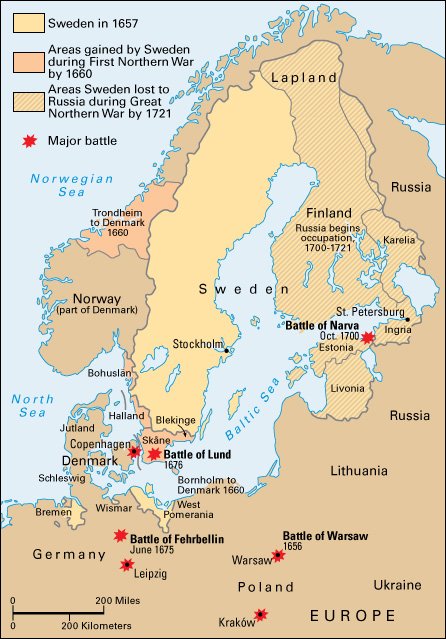Northern Wars were a series of wars in northern Europe between 1655 and 1721. During these conflicts, Brandenburg (now part of Germany), the kingdoms of Denmark and Norway, the Netherlands, Poland, Russia, and Sweden fought for control of areas around the Baltic Sea.
The First Northern War.
In 1655, King Charles X of Sweden invaded Poland. Charles took the city of Warsaw and attacked Kraków before an uprising stalled the Swedish forces. Austria, Denmark, and Russia declared war on Sweden after Swedish and Brandenburg forces defeated the Polish army at the Battle of Warsaw in 1656. Swedish forces left Poland to invade Denmark, and Brandenburg switched sides, joining the anti-Swedish alliance. Sweden occupied Jutland and laid siege to Copenhagen. The war ended in 1660 with a series of treaties. Sweden failed to achieve any significant gains on the European mainland, but it secured the provinces of Skåne (also called Scania) and Blekinge from Denmark.

The Scanian War.
The Skåne region in southern Sweden became the site of much fighting in the Scanian War of the late 1670’s. The Netherlands, or the Dutch Republic, had been at war with England and France since 1672. After England made peace with the Dutch in 1674, Brandenburg joined Denmark in an alliance with the Dutch, while the Swedes allied with France.
Swedish forces invaded Brandenburg but were defeated at the Battle of Fehrbellin in June 1675. The Swedish navy suffered a string of defeats, and the Swedes lost their German possessions of Bremen, Pomerania, and Wismar. Denmark invaded Sweden in 1676, but the Danes were defeated at the bloody Battle of Lund. The French and Dutch signed a peace treaty in 1678. Sweden, as France’s ally, regained most of its lost German territories with the end of the Scanian War in 1679.
The Great Northern War.
In March 1700, under King Frederik IV, Denmark invaded Schleswig and defeated the duke of Holstein-Gottorp, Sweden’s ally. The Swedes then attacked Denmark, and by August they had forced Denmark to make peace. In October, King Charles XII of Sweden moved his army to Livonia, in present-day Estonia, where he defeated a much larger Russian army at the Battle of Narva. Charles then attacked Saxony (now part of Germany) and Poland, taking Warsaw and Kraków. A Swedish victory at Leipzig forced King Augustus II of Poland to surrender his crown.
Meanwhile, the Russian czar (king) Peter I began rebuilding his army and sought to challenge Sweden’s power in northern Europe. Peter seized the Swedish territory of Ingria, founding the city—and future Russian capital—of St. Petersburg there in 1703. By 1709, when the Swedes battled the Russians in present-day Ukraine, the Russians fielded a much-improved force compared with the one that lost at Narva in 1700. After a series of small but bloody skirmishes, the Swedish and Russian armies collided at Poltava in July 1709. The Swedes were overwhelmed, losing nearly their entire army. By 1714, Russian forces had occupied most of Finland.
Further military action resulted in much bloodshed. Russia forced Sweden to make peace after Charles XII was killed during a siege in Norway in 1718. A series of treaties were signed between 1719 and 1721. By the terms of the agreements, Russia gained the territories of Estonia, Ingria, Livonia, and part of Karelia, and the country emerged as the leading power in the areas around the Baltic Sea. The lengthy warfare left Sweden in poor economic, military, and political condition.
